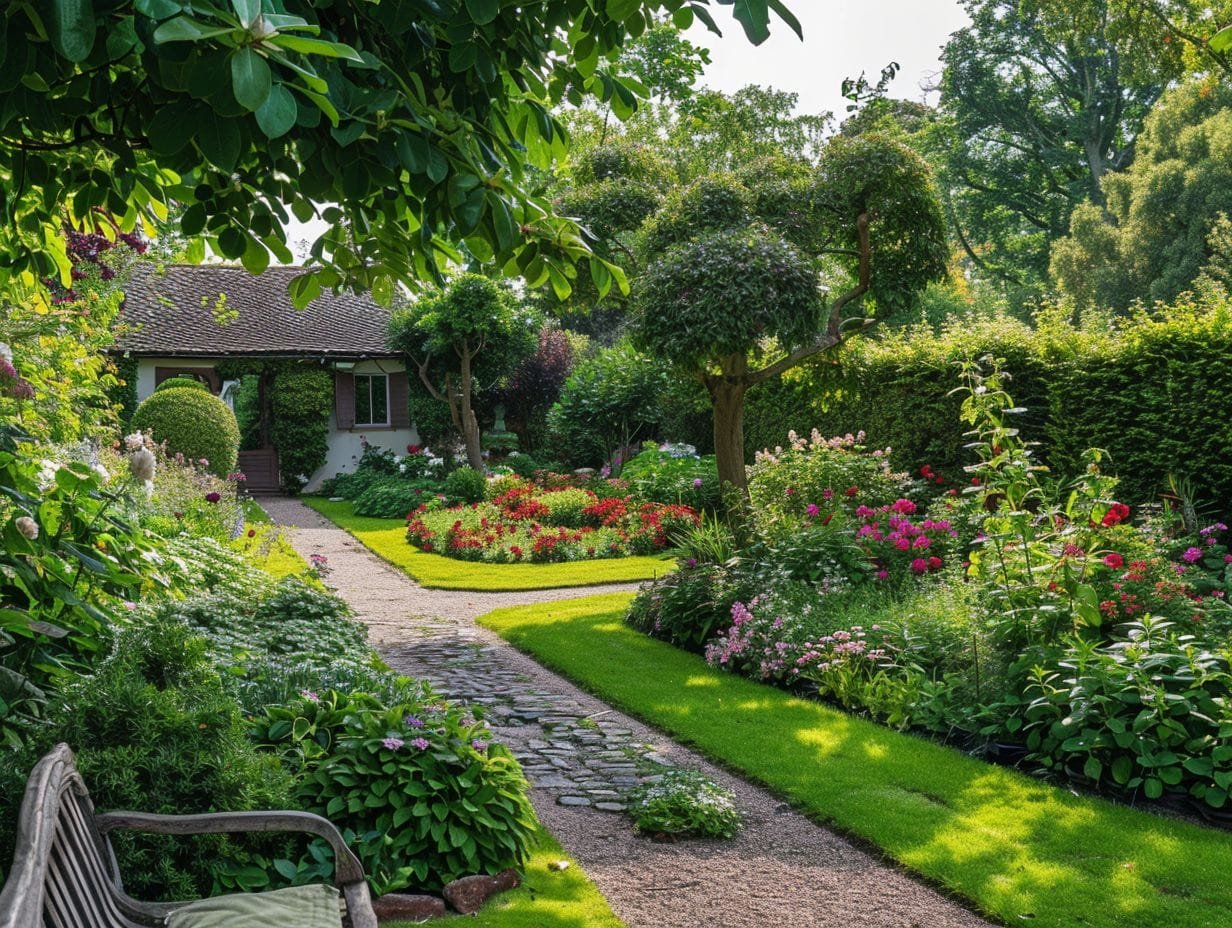Are you seeking a more leisurely approach to garden care, aiming to reduce the time and effort spent on maintenance activities? Consider the option of establishing a low-maintenance garden.
This comprehensive guide will delve into the myriad advantages associated with low-maintenance gardens, ranging from time and cost savings to streamlining gardening tasks. Additionally, guidance will be provided on the planning, design, and upkeep of a low-maintenance garden, along with highlighting common errors that should be avoided.
Prepare to unwind and relish in the tranquility of your stress-free outdoor haven.
Benefits of a Low-Maintenance Garden
A low-maintenance garden presents various advantages, serving as a convenient and economical option for cultivating outdoor aesthetics that conserves time and energy, thereby augmenting the surrounding environment.
Time and Cost Savings
The implementation of a low-maintenance garden design can result in notable time and cost efficiencies due to reduced requirements for frequent maintenance and resource allocation.
Utilizing native plants that are compatible with the indigenous climate and soil characteristics can substantially diminish the necessity for extensive watering, thus leading to decreased water expenses and preservation of this valuable resource. The integration of mulch and efficient irrigation systems can additionally contribute to a reduction in water consumption. Sustaining a low-maintenance garden also entails diminished expenditures on fertilizers, pesticides, and equipment, thereby fostering both financial and environmental sustainability.
Planning for a Low-Maintenance Garden
Effective planning is crucial for the development of a low-maintenance garden that optimizes outdoor space, all the while adhering to environmentally friendly and sustainable practices.
Choosing Plants and Layout
The selection of appropriate plants and layout is essential in establishing a low-maintenance garden that emphasizes drought-resistant and easy-care plant species that flourish with minimal maintenance. When choosing plants for the garden, it is advisable to opt for varieties such as lavender, succulents, and ornamental grasses that demand minimal water and care. By integrating a combination of these plant types, an energetic and sustainable garden design can be achieved.
It is beneficial to group plants with similar watering requirements together to enhance the efficiency of watering practices. The creation of distinct pathways and utilization of low-maintenance ground covers can contribute to reducing the necessity for frequent weeding and trimming, ensuring that the garden remains aesthetically pleasing with minimal effort.
Tools and Equipment
Utilizing appropriate tools and equipment can significantly improve the effectiveness of gardening maintenance in a low-maintenance garden. For instance, possessing a robust pair of pruning shears is crucial for trimming plants and maintaining their appearance. A reliable garden hoe facilitates the effortless weeding of garden beds, and a rake is invaluable for soil leveling and mulch distribution. Ensuring adequate hydration for plants is essential, achieved through the use of a watering can or a hose equipped with a spray nozzle. Furthermore, acquiring high-quality gardening gloves is recommended to shield hands from thorns and rough surfaces during garden work.
Designing Your Low-Maintenance Garden
Creating a low-maintenance garden entails strategic garden design and landscaping approaches that prioritize sustainable landscaping practices and the improvement of outdoor aesthetics.
Principles of Low-Maintenance Design
The principles governing low-maintenance design are centered on the concept of garden simplicity, the integration of natural elements, and the adoption of sustainable practices.
By simplifying the elements present in the garden, one can establish a layout that demands less maintenance and time commitment. The incorporation of native plants and trees serves to amplify the garden’s natural characteristics while simultaneously diminishing the necessity for excessive watering and care. Embracing sustainable practices such as composting and mulching can contribute to naturally enriching the soil and fostering an environment within the garden that is more self-sustaining.
To effectively implement these principles, it is advisable to begin by evaluating the space available and identifying the plant species best suited to thrive in the local climate and soil conditions.
Incorporating Hardscaping
The integration of hardscaping elements in a garden can significantly reduce maintenance requirements while delivering aesthetically appealing and durable garden features with minimal exertion. Stone pathways and patios contribute both functionality and visual charm to an outdoor area, necessitating less maintenance in comparison to conventional gardening techniques. By incorporating non-plant elements such as gravel beds or decorative rocks, an individual can fashion a visually captivating garden that is easily maintainable.
The inclusion of hardscaping solutions like retaining walls not only elevates the overall appearance of a garden but also aids in the management of soil erosion and efficient water runoff control. These hardscaping additions ensure a durable and low-maintenance garden setting, enabling individuals to relish their outdoor space without the continual burden of upkeep.
Maintaining a Low-Maintenance Garden
The upkeep of a low-maintenance garden necessitates the application of effective gardening techniques and strategies to guarantee proper plant care and overall garden health, all while minimizing required effort.
Essential Tasks and Tips

Concentrating on a select few vital tasks can enhance the efficiency of garden maintenance, ensuring the continued health and vibrancy of your low-maintenance garden.
Weeding on a regular basis is imperative to prevent the intrusion of unwanted plants that may compete for nutrients and sunlight with your garden plants.
The application of mulch around your plants serves to aid in moisture retention in the soil, minimize weed growth, and regulate soil temperature.
Pruning represents another crucial endeavor aimed at the maintenance of plants’ shape and health, ultimately fostering improved growth.
The removal of faded flowers, or deadheading, can stimulate continuous blooming throughout the entirety of the season.
Adhering to proper watering practices, tailored to meet the individual needs of various plant species, stands as a fundamental aspect in ensuring their overarching health and vitality.
Common Mistakes to Avoid
Preventing common gardening errors is essential for ensuring the success of a low-maintenance garden, particularly in comprehending the needs of plants and their maintenance requirements.
Overlooking Plant Needs
Failure to consider the specific needs of one’s plants can result in gardening difficulties, even within a low-maintenance environment. Understanding the unique requirements of one’s botanical companions is crucial for promoting robust growth and vibrant blossoms. It is imperative to take into account factors such as sunlight exposure, watering frequency, soil composition, and temperature preferences to ensure optimal plant health.
A practical gardening strategy involves grouping plants with similar needs together to facilitate streamlined care management. It is essential to exercise caution regarding the watering regimen, as overwatering or underwatering poses a significant risk to plant well-being. Regularly monitoring foliage for indications of pests or diseases and promptly addressing any concerns are essential practices to sustain a verdant and blooming garden.
Underestimating Maintenance Needs
Failing to adequately anticipate the maintenance requirements of one’s garden can lead to unforeseen difficulties and an increase in labor.
Proactive measures can significantly contribute to streamlining the upkeep of a garden. Adhering to a regular watering regimen, applying mulch to preserve moisture levels and inhibit weed growth, and removing spent blooms through deadheading all constitute integral components of a well-devised maintenance strategy. Additionally, it is essential to periodically enrich the soil with fertilizer and trim excessively overgrown plants to facilitate robust development. By diligently addressing these responsibilities, one can relish a thriving garden without succumbing to overwhelming maintenance demands. It is imperative to recognize that consistent, conscientious efforts can culminate in the creation of a striking, low-maintenance garden over time.
Enjoying Your Low-Maintenance Garden
The concept of a low-maintenance garden presents numerous opportunities for outdoor recreation and relaxation, enabling individuals to enjoy a beautiful outdoor environment with minimal exertion.
Whether one’s preference is to engage in solitary activities such as reading in the shade of a tree, host informal social gatherings on a patio, or take leisurely walks amidst a vibrant array of blooming flowers, a low-maintenance garden offers a diverse range of possibilities for unwinding and reconnecting with nature.
By cultivating a tranquil outdoor sanctuary that demands minimal maintenance, individuals can effectively reduce stress levels, enhance their overall mood, and potentially improve their physical well-being through activities like light gardening or practicing yoga in the fresh open air.
